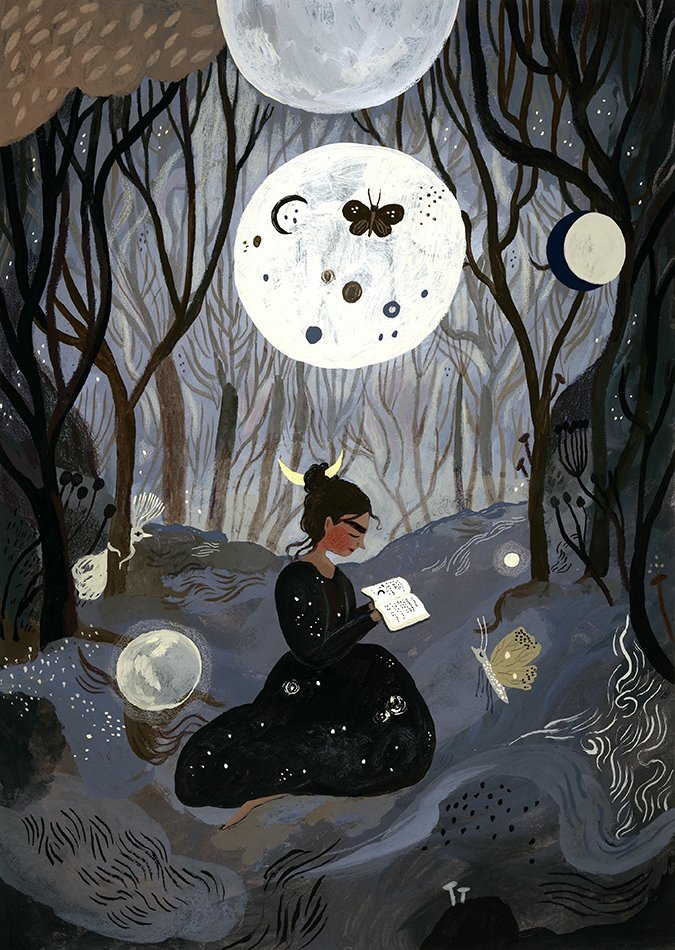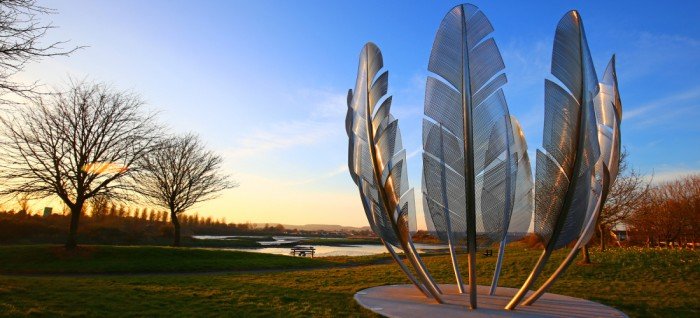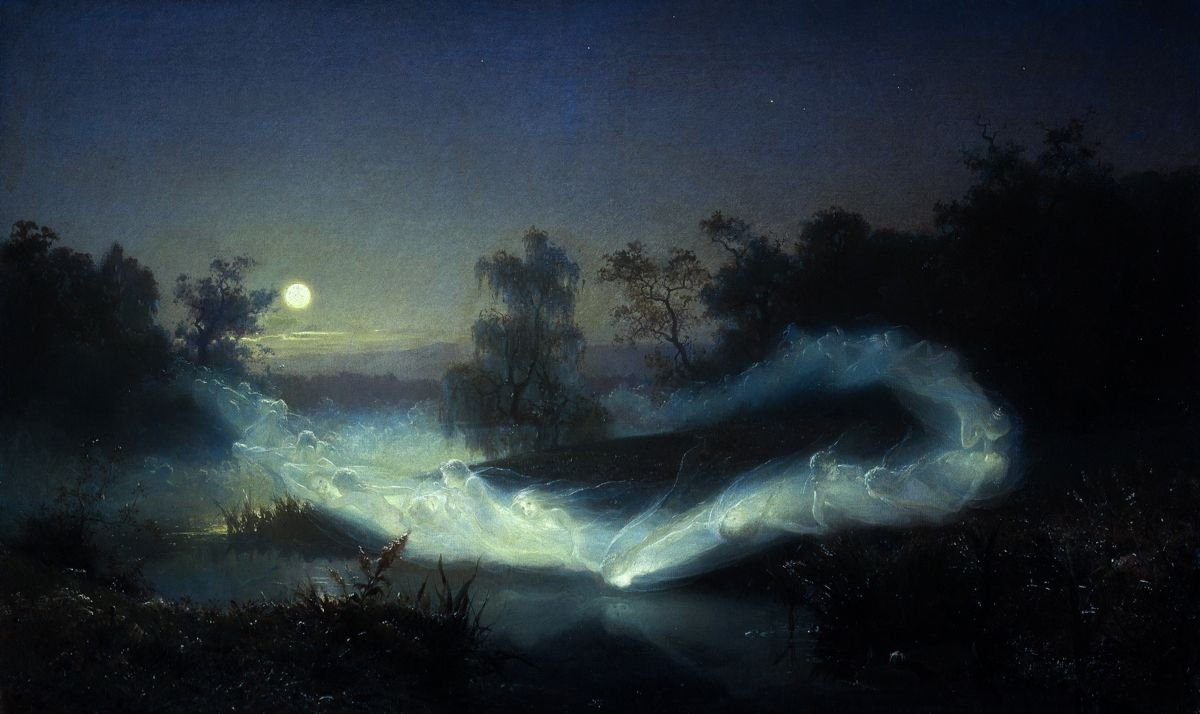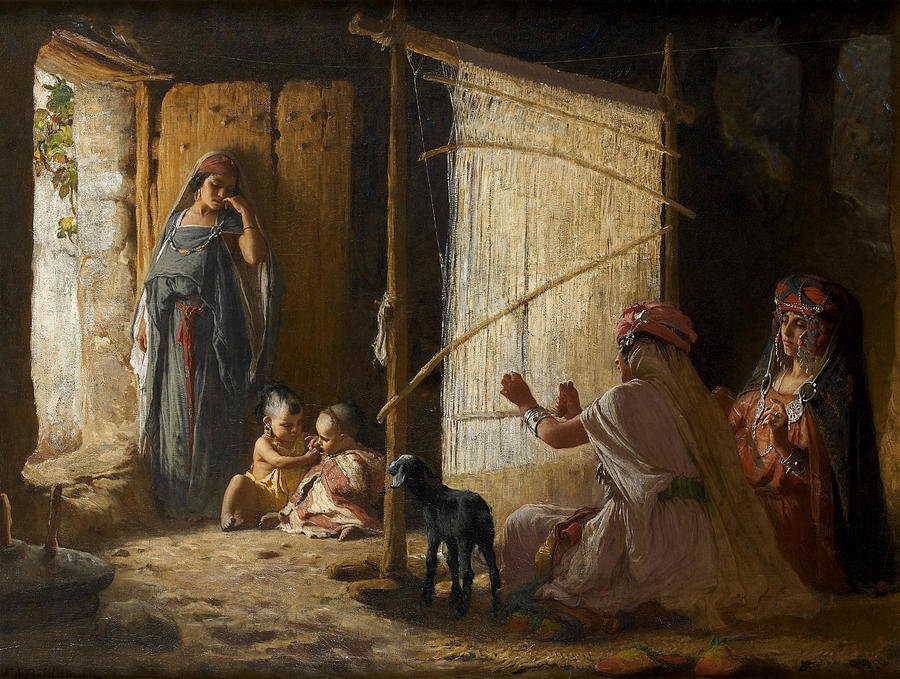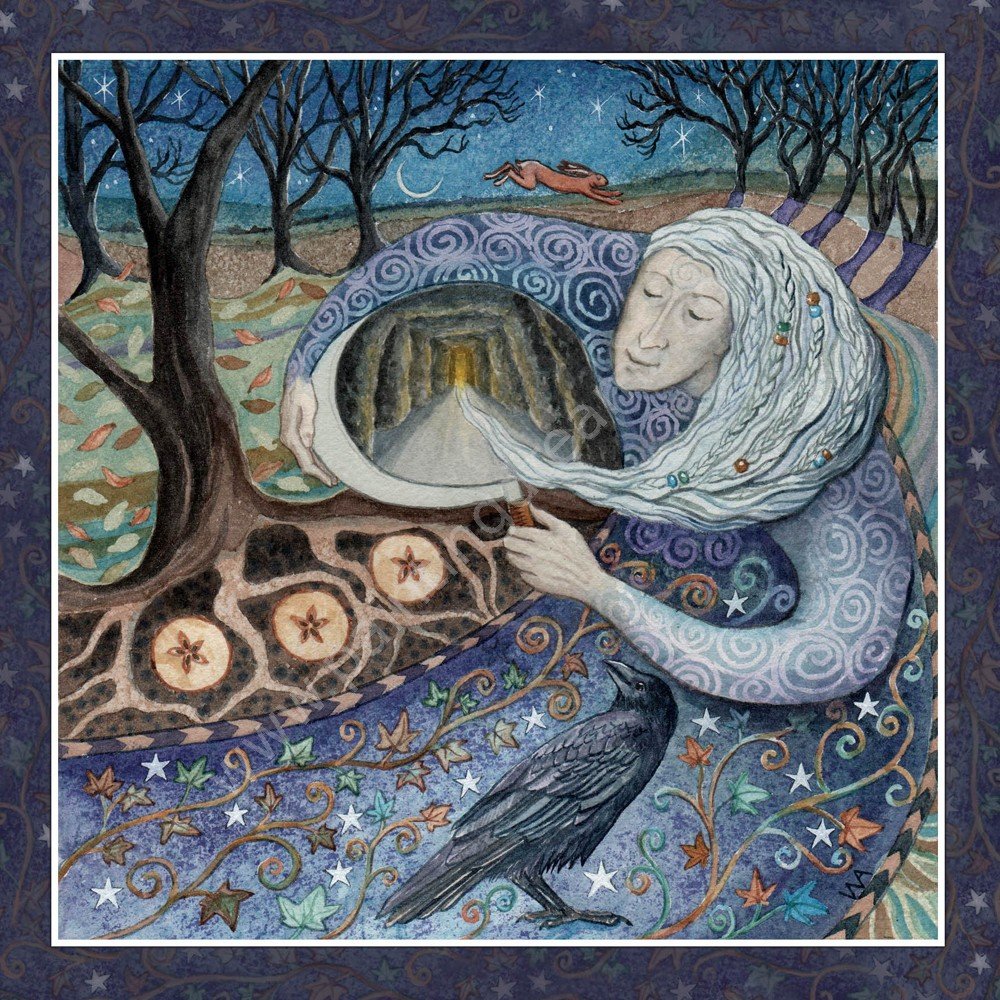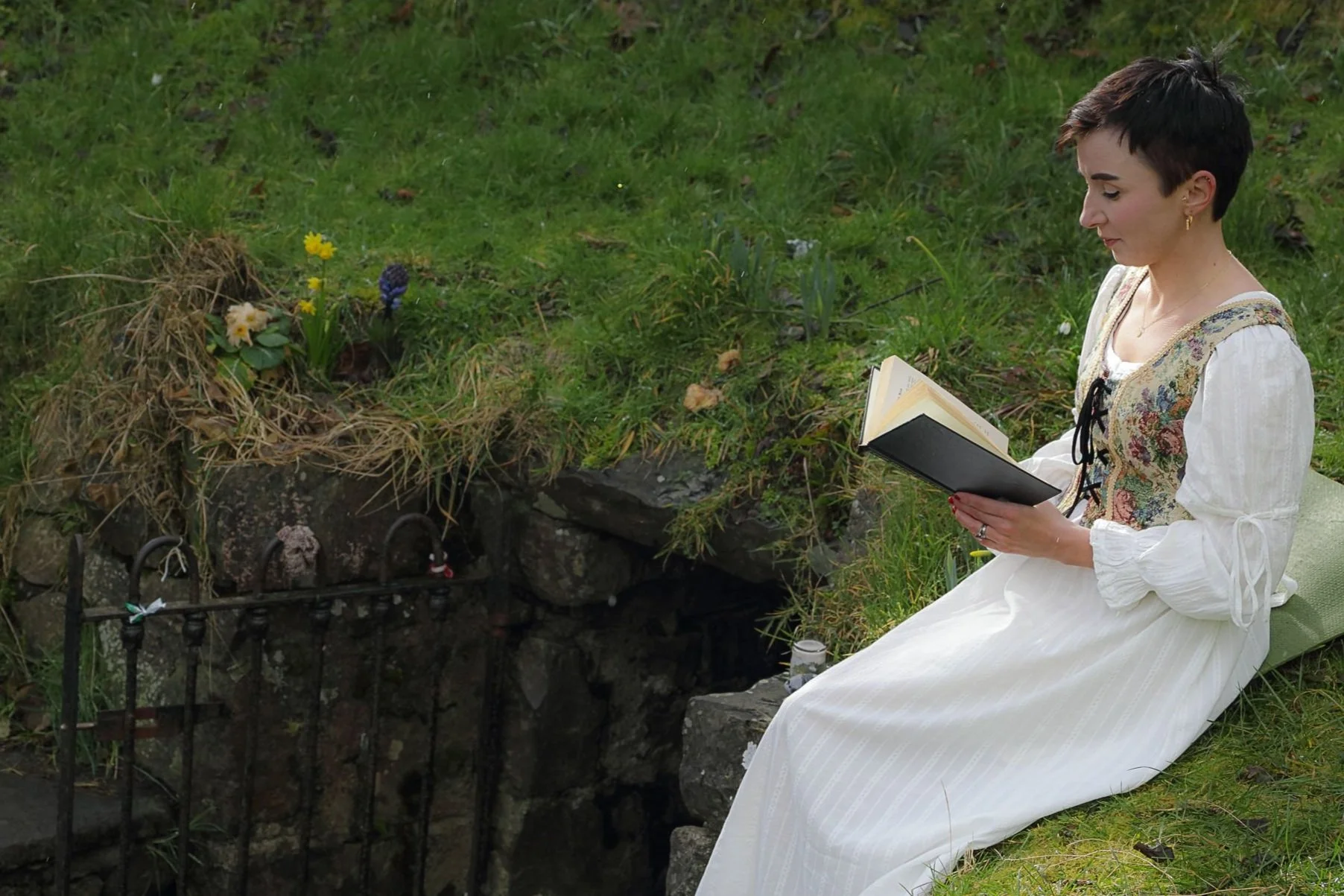
MUSINGS FROM THE OTHERWORLD
My current writings and musings on Celtic feminine mysticism and soulful living now find their home on Substack. I invite you to join me there but I’ve also preserved an archive of my previous writings (2021-2023) below.
A Letter Writing Ritual
These letters were given to me after my Gran passed 15 years ago, they were found among others that I wrote in a treasured box she kept. She is now a well and wise ancestor who I feel as deeply connected to as when she was alive. And so this winter, I am continuing to write to her sharing about my inner and outer landscapes.
Art by Johannes Rosierse
“You have a touch in letter writing that is beyond me. Something unexpected, like coming round a corner in a rose garden and finding it still daylight.”
Virginia Woolf
Recently, I found a letter posted on 21st June 1999, the summer solstice in the last year of that decade, that I sent to my grandmother, Frances O’Sullivan, my gorgeous “Gran”. I was a teenager at the time away without my family studying Gaeilge/Irish in the Gaeltacht in Co. Donegal. This was my third summer to go away to study Irish and so I was used to the experience by this stage.
As my eyes fall upon my own writing, it’s curious to read now 24 years later what was happening in my inner landscape… how I was feeling, the small little revelations I was having about the language, an experience of a “blind date” that made me laugh so much I was nearly sick, something I have no recollection of now (it must have been a school sketch or show we put on)!
I also shared about my outer landscape, about the Bean an Tí, the “Woman of the House” and her small children who were the age that my own children are now. How they were bilingual and adorable. The Céilí’s, the dances each night and the craic of losing the run of ourselves, swinging one other so hard that we’d take flight during The Siege of Ennis (one of the dances).
These letters were given to me after my Gran passed 15 years ago, they were found among others that I wrote in a treasured box she kept. She is now a well and wise ancestor who I feel as deeply connected to as when she was alive. And so this winter, I am continuing to write to her sharing about my inner and outer landscapes.
Letter Writing Ritual
This is an invitation to write a letter to a well and wise ancestor or a mythic ancestor this Samhain. For example, you might like to write to the Cailleach, the Gaelic Goddess, our Seanmháthair Naofa, our Sacred Grandmother, who is deeply associated with these winter months in Ireland/Éire, the Isle of Man/Ellan Vannin and Scotland/Alba. Or whoever calls to you at this time, listen and you’ll hear them whisper.
The Tradition by Julia Jeffrey
Open up your ritual space before you write, light a candle to honour the flame of your lineage, both clan and mythic ancestors.
Remember, when you handwrite, you are literally shaping your words with your body. Your handwriting is utterly unique to you, and so as you write in ways you create and recreate yourself.
Share with your ancestor about what’s happening in your inner landscape, your world of thoughts, emotions, feelings, sensations and intuitions.
Then share about your outer landscape, what is happening beyond your window in the world? How does the outer world relate back to your inner world?
Write with free abandon in full honesty so as not to lie to yourself or to your ancestor.
What guidance would you welcome in a return letter from your ancestor? This may come to you in the form of a dream, a synchronicity, an intuitive spark - a mirroring back to you.
If ever there’s been a time to remember our global interconnectedness, it is now. Let the Goddess be your guide.
The Otherworld by Tijana
Once you have written your letter, you can place it in an envelope, even address it if you like, allow the spell of your imagination to work its wonder.
Then place your letter on your altar, or a sacred space, or you can write a series of letters and continually wrap them in string. You will know what to do. They are your keepsakes.
In time, reopen your letter and journal in response to the guidance that did come to pass. Perhaps at the Winter Solstice or Imbolc or whatever season you find yourself in.
“She is ideas, feelings, urges, and memory. She has been lost and half-forgotten for a long, long time. She is the source, the light, the night, the dark and daybreak… She is the one we leave home to look for. She is the one we come home to.”
Clarissa Pinkola Estés
Voices of Celtic Wisdom
I am thrilled that I will be joining the teaching team of Voices of Celtic Wisdom. This is a 4-month programme exploring living threads of the earth-based cultures of Ireland, Scotland, England and Wales with song, story, lore and hands-on crafting workshops.
Other teachers include Dolores Whelan, Manda Scott, Angharad Wynne, Tara Brading, Mary McLaughlin, Danu Forest, Dougie MacKay, Seoras Macpherson… and more wondrous souls.
The programme runs from 30th November 2023 to 25th March 2024.
We all have a Mythical Lineage
We all have a mythical lineage. But what happens when we are severed from our mythical traditions? How do we dream the myth onwards? How do we go walkabout in the cultural dreamtime to regenerate our mythical lineage in service to our lives, our families, our communities, and our world?
Eve (The Dreaming) by Jana Heidersdorf
We all have a mythical lineage. Or many mythical lineages. We all descend from ancestors who were storytellers. Whose mythology told the story of their people—their story, which is now our story to evolve as inherent in these ancestral myths is wisdom we so desperately need for our times. As Jung said, we must:
“…dream the myth onwards and give it a modern dress.”
But what happens when we are severed from our mythical traditions? How do we dream the myth onwards? How do we go walkabout in the cultural dreamtime to regenerate our mythical lineage in service to our lives, our families, our communities, and our world?
Well first, we must understand that this severance is a problem. A problem that together we can seek to solve. As the fairytale always tells us, each one of us holds the golden key.
The Golden Key by John Bauer
Mythological Displacement
Before I founded my business, the Celtic School of Embodiment, I worked for 14 years in global justice and human rights. During this time, I met many people who were experiencing ‘displacement’ either within their own country’s borders as an Internally Displaced Person (IDP) or across an international border, as a refugee. Displacement is the coerced movement of people from their home territories due to life-threatening factors like natural disasters, climate-induced disasters, war, persecution, corruption and human rights violations.
Displacement forces people to flee their homes, often that of their ancestors, and in consequence, causes immense psychological and bodily trauma. In addition to the wounding of the life-threatening event itself, displacement ruptures peoples’ connections to the cultural psyche and their mythological roots; the stories of their people. In the West where we have succumbed to the plague of rationalisation, the loss of our native myths may not seem as grave as the loss of life. It’s not. And yet, it has serious ramifications, which I believe we are only starting to see particularly in countries with a history of settler colonisation.
Myth is not primitive nor is it fabrication nor is it children’s stories. There is no singular purpose to myth, but in most cultures, myth facilitates the conditions for people to engage in the sociocultural, natural, and supernatural worlds that surround them and illustrates through story a range of effects that individual action can have on these multiple worlds. It can contribute to a person’s physical, mental, emotional and spiritual wellbeing. Myth and place are often inextricably linked. Myth helps people anchor in their physical and metaphysical place in the world. Not that this needs to be static. Any romanticised notion of ‘pristine’ mythology that is void of an agenda and has been isolated from interactions with other peoples and cultures, is a fallacy.[1] Myth is fluid and should flow with the times.
Still, we are living in an epoch of mythological displacement. In a time when people are displaced or have been moved away from their mythical lineage. I believe that this is detrimental to our wellbeing and I see from the women I work with, how this is amplified when we are not living on the land of our ancestors. While some of us like myself may live in the places where our forebears were born and died, many more do not. Sometimes that is by choice, and other times it is due to factors outside of our control like ancestral migration, colonisation and displacement. Yet for all of us, the felt sense memory of our ancestral home remains buried in our bodies. Just as the old bone woman haunted Gobnait (you can find this tale here) from beneath the top waters so too does ancestral memory haunt us from the unconscious, begging for our attention.
Amžinybė (Eternity) by M. K. Čiurlionis
A History of Displacement
For a small country, Ireland has a colossal legacy of displacement. Numbers vary but the Irish Diaspora is around 70 million people. Of these, 36 million are in America. The remainder are in the UK, Canada, Australia and New Zealand, and small populations in Continental Europe and Central and South America.[2] A historical catalyst to this was the Irish Famine, An Górta Mór, ‘The Great Hunger’, which was the greatest social disaster in 19th century Europe. Over 2 million people, a quarter of the population either died or emigrated. Ireland was under the rule of the British government at the time whose policies premised on racism, classism, and structural violence did not provide an adequate response, it failed the Irish people.
There were aid efforts within Ireland, Britain, and across the world. One donation that is remembered with reverence within Irish cultural memory is that of the Choctaw Nation who gave $170 to relieve famine suffering. This generosity came from a people who at the time were experiencing ethnic cleansing and forced displacement by the American government led by a Scots-Irish descendant, President Andrew Jackson. To take action to ease the suffering of another peoples amidst the horror of their own suffering was a profound act of human solidarity. In the Choctaw myth of emergence, the people are said to have emerged into this world from a mother mound, Nanih Waiya, ‘Leaning Hill’. In Irish tradition, the Áes Sídhe, the ‘People of the Mound’, our supernatural ancestors and otherworldly beings emerge from the fairy mounds, the hallow hills, and the Otherworld to interact with our world. Like in these instances where land and myth are interwoven, the displacement of peoples from their ancestral homes can be spiritually devastating.
Kindred Spirits sculpture in Midleton, Co. Cork honouring the contribution made by the Choctaw to starving Irish people in 1847
Subtle Displacement
Mythological displacement does not only happen with the forced movement of people, it can occur in more seemingly subtle ways. One example of this is the displacement of a native language with a non-native tongue. We see this with Gaeilge (Irish Gaelic), the Irish language and English. Every placename in Ireland tells a story. When you read Irish mythology, you will find long passages telling the story of how a placename came to be. Yet the history of place is complex in Ireland because our placenames are no longer in our mother-tongue, they were anglicised. This not only displaced the majority of the population from our language but also from our deeper sense of place and ancestry on our land.
To provide an example, a town near where I live is called 'Ardee'. Its meaning is hidden in its anglicised form. The Gaeilge for Ardee is ‘Baile Átha Fhirdhia’ which translates as 'The Townland of the Ford of Ferdia'. The story of this place is about a devastating duel at a ford between two warriors, Cú Chulainn (Koo Chul-an) and Ferdia (Fer-dee-ah), both of whom trained under the talented warrior woman, Scáthach (Scah-hock) on the Isle of Skye in Scotland. Not only were Cú Chulainn and Ferdia brothers in arms but some believe, potentially lovers. You can know none of this when you know the town only as 'Ardee'. Like how modern branding works, this is an incredibly effective tactic of assimilation.
Scáthach by PJ Lynch
Capitalist Displacement
Culture is a natural phenomenon across all human societies but culture itself is not natural, it is learned. Culture's mode of communication is predominantly symbolic. Different cultures share information in different ways, but they do so through symbols. These symbols could be the likes of words, gestures, behaviours, actions, and objects that are all inferred with meaning by a given culture. From birth, as you grow, you absorb these symbols and learn how to speak your culture fluently. Capitalism also behaves like a culture. It is not natural, it is constructed. Capitalism diffuses its own series of cultural symbols through the image of global brands (think Apple) that mass media then manipulates us into consuming through influencers. In capitalist spirituality, deities are celebrities, sites of worship are stores or anywhere we can consume, and our votive offering is money.
With capitalism, comes the idea of ‘development’, the lie of eternal progress that we all seem to be working towards. Some countries are ‘developed’ so better, others are not so worse. Development is a Western notion that has no equivalent in many languages. It is not natural or universalistic and does not appear in all cultures. Rather, it is a practice by which the existence and destinies of non-Western societies are formed via a Eurocentric mode of imagining and perceiving the world.[3] This impression of development creates a false polarity between the traditional and the modern, a deception whereby indigenous peoples are often characterised as primitive, having existed without history until the arrival of Europeans.[4]
The idea of modernisation has been propagated with such force globally that it is glorified as a universal goal and any deviation is subsumed under a negative, ‘traditional’ classification. Mythology exists within the traditional. It is not modern and so is perceived as less than. Where you have a racialisation or othering of the mythic or folkloric beliefs of a peoples like in Ireland under British rule, the obsession with modernisation intensifies because we have to be seen to be progressing, to be rational, to be intellectual, to lose our backwardness. It’s a survival tactic. A consequence of this is that our mythology loses its power, and we fall out of our enchantment with the world. Writing over one hundred years ago, German Sociologist Max Weber warned:
“As intellectualism suppresses belief in magic, the world’s processes become disenchanted, lose their magical significance, and henceforth simply ‘are’ and ‘happen’ but no longer signify anything.”
Dancing Fairies by August Malmström
White Supremacy Displacement
Capitalism’s greatest lover is white supremacy culture, an ideology that creates a hierarchy of imagined racialised value, where like modernisation, whiteness or white culture is the desired result; white middle and owning class to be specific. It constructs who is of value and human, and who is not in the name of profit, power and ‘progress’ at all costs.[5] This is a sinister form of colonisation, of ‘power over’ as it displaces us from ourselves, our hearts, our bodies, our spirits, one another, and nature.
In White Supremacy Culture – Still Here, Tema Okun and colleagues at dRworks articulate how white supremacy culture violates the humanity, ways of knowing, ancestral land and livelihoods of indigenous people, while exoticising, romanticising and culturally appropriating the wisdom and customs held within these communities. Indigenous people often maintain historical continuity with pre-colonial culture and form non-dominant groups within society.[6] We see this in Ireland with the Traveller (Mincéirí) community who have been vilified, ostracised and forced to ‘settle’, a form of displacement, by the Irish government, as Ireland upon independence used much of the same institutional structures imposed by the British Empire.
Even in our education system, which mirrors the British system and was formed in collusion with yet another colonial power, the Catholic Church, our mythology is taught as imaginary tales for children. Okun stresses how academia defines the “classics” as Greek and Roman, white and male. ‘Classic’ conjures the image of the highest possible quality—forever—and in this way gives superiority to a particular way of knowing so that Greek and Roman becomes the mythology of the West. These mythologies do, of course, speak to archetypal patterns that appear cross-culturally and are fundamental to understanding the Western Psyche as are their many Egyptian roots. But we have access to a rich broth of other mystery traditions, some of which have been relegated to the margins for not conforming to this model of classic. Why not have this, and more please?
“Looking back behind the modern severance of spirit from nature, we can find an important source of Western culture in the myths, art, music, folklore and traditions of pre-Christian Ireland. This material is as important for understanding ourselves as Egyptian, Greco-Roman and Judeo-Christian influences.”
Sylvia Brinton Perera, The Irish Bull God
Irish mythology does not equate to whiteness. Irish bodies come in a gorgeous spectrum of colours and diverse lineages. This extends beyond our small island to our Diaspora, where for example, it is estimated that 38% of African Americans have Irish Ancestry.[7] This fills me with hope for our mythology as our diversity can fuel innovation and creativity. My work is my way of weaving a new tapestry for our mythical lineage but we need many diverse threads!
Women in Biskra Weaving the Burnoose by Frederick Arthur Bridgman
The Legacy of Mythological Displacement
I work predominantly with women who are first-generation Irish, or of Irish or wider ‘Celtic’ heritage. 80% of the women who cross my threshold live beyond Irish shores. I see this legacy of mythological displacement everywhere in my work. Common themes that emerge from my clients and community are:
Feeling disconnected from their lineage(s)
Feeling like they don’t know where they belong
Identifying as biracial or multiracial and navigating multiple lineages
Holding shame about not knowing more about their mythological heritage
Carrying intergenerational grief and trauma
Being haunted by the ghost of ancestral loss that they cannot make sense of
Seeking and, or, potentially appropriating from other cultures, or fear of doing so
Being a settler on the stolen land of indigenous peoples
A Remedy for Mythological Displacement
So, what’s the remedy? How do we travel the road from mythological displacement to finding our way home? I don’t live in your body so it would be remiss for me to dictate a solution to the complexities of mythological displacement. That acknowledged, in my experience, there are three standing stones that generate the soulful conditions for you to (re)discover your own location for home within your lineage.
The Wild Swans by Jackie Morris
1. Become Intimate with Your Mythical Family
You are not simply your life and your life simply you, there are spiritual forces that arise from the collective unconscious—your mythical kinsfolk—who are naturally invested in your life. Who conspire to guide you to self-actualisation, to fulfil your life’s Calling. This cannot happen without reciprocity—you have to be interested in them to see their interest in you.
Tend to the archetypes that your ancestors brought to life to shape their world and the native faces they bequeathed these archetypes—the goddesses, gods, and mythical beings of Irish mythology. This is your mythical family. If you hold multiple lineages, invite your full family in, all lines. Jung believed that ancestral experience remained alive within the sea of the collective unconscious. Myth is one of the most powerful ways we can access this unconscious so that we can learn from our mythical and human ancestors. What would they wish for us to know?
In this way, myth is always evolving and can serve to illuminate the foresight we need for our lives, our families, our communities, and our world. We are living in an unprecedented era of crisis as our planet revolts through climate change against the toxicity of our relationship with it, which I believe mythological displacement exacerbates. Deepening your relationship with your mythical family is deepening your relationship to Mother Earth. We have to dream with our mythical ancestors and allow these visions to be of service.
2. Unveil your Divine Feminine Heritage
When we venture into the Otherworld of our mythical lineages, we see how the ‘original’ sources are often tainted with a patriarchal hand as is the case with Irish mythology and its Christian scribes. We have to lift the veil in search of the feminine, to excavate her from the ashes of mythological memory. It is no coincidence that the domination and subjugation of nature and the feminine are killing our planet. And so, when we find the feminine in our myths, we must allow her wisdom to metabolise through our bodies so we can inhabit her more fully. We must welcome the full spectrum of the feminine into our lives so that we ourselves can become more alive. She has been missing and we are dying without her. Rest assured there is no shortage of big feminine energies in Irish mythology. We have much to work with.
3. Partner with Your Body
You could go and read books on Irish or Celtic mythology and the feminine, which are still few and far between, we desperately need many more. Yet for me, what is missing entirely from experiences of myth and the feminine in the Irish and Celtic context, is the body. To paraphrase Marion Woodman, we can only hear our authentic voice when we discover and love the goddess lost within our rejected body. And so let me repeat what I said above, it is no coincidence that the domination and subjugation of nature and the feminine—and the body—are killing our planet. We have rejected all three. We have displaced all three. When you drop the stories of your mythical ancestors into your body and allow them to coarse through the veins of your own life stories, this is where the magic, the re-enchantment happens.
Samhain by Wendy Andrews
I Feel Like I’ve Come Home
What happens when you become your own custodian of these three standing stones? It may sound like a cliche but the most common response I hear is, “I feel like I’ve finally come home.” This is frequently accompanied by:
Deeper acceptance and love of self
Honouring your Irish or wider Celtic lineage, and other lineages from an embodied and internally resourced place
Rootedness in your own sense of what it means to belong in this world
Release from ancestral grief and trauma
Confidence to engage in cross-cultural relationships in celebration of our human diversity and our interconnectedness
Trust to reimagine your lineage(s) free from dogma and make your own poiesis with this in service to others and these times
And when you stir feminine stock into this broth, women are energised with personal:
Sovereignty: A stepping forth into life as an embodied expression of power within, as a sovereign woman
Sensual Aliveness: A cultivation of your external senses, along with the nebulous world of your internal felt senses as a gateway to living a full-flavoured enchanted life
Becoming: An implosion of creative lifeforce. Surrendering to cyclic rhythms and embracing all seasons in acceptance of your ever-unfolding unto life
‘“O Brigit!” said Ogma, “before you go tie a knot of remembrance in the fringe of your mantle so that you may always remember this place—and tell us, too, by what name we shall call this place?” “Ye shall call it the White Island,” said Brigit, “and its other name shall be the Island of Destiny, and its other name shall be Ireland.” Then Ogma tied a knot of remembrance in the fringe of Brigit’s Mantle.’
- Ella Young, Celtic Wonder Tales
You remember the knot in your mantle, I know you do.
References
[1] Wolf, E.R. (1982) Europe and the People Without History. University of California Press
[2] Irish Emigration Patterns and Citizens Abroad 2017, Department of Foreign Affairs, Ireland
[3] Tucker, V. (1992). The Myth of Development: A Critique of a Eurocentric Discourse. In Munck, R. & Hearn, D. (eds). Critical Development Theory: Contributions to a New Paradigm. London: Zed Books
[4] Sahlins, M. (1999). What is Anthropological Enlightenment? Some Lessons of the Twentieth Century. In Sahlins, M. (eds.) Culture and Practice: Selected Essays. Zone Books: New York
[5] Okun, T. (2021) White Supremacy Culture – Still Here. whitesupremacyculture.info
[6] United Nations Permanent Forum on Indigenous Issues
[7] African American Irish Diaspora Network
Becoming An Ancestor
My boyfriend and I walked hand-in-hand, but we weren’t alone. All throughout the funeral, I’d felt a presence sitting next to me on the pews, watchful and wide-eyed. As we walked towards the graveyard, I felt her soft, warm hand in mine.
By Amelia Furlong
Samhain as an event has come and gone, but the effects of this year’s Celtic new year are still lingering in my mind.
Samhain is often viewed as a time for releasing what desires to die. I interpret this as a time when I release the old me; a rebirth from ambitions and patterns that no longer serve me to new, purpose-driven ones.
In fact, I even decided to move to Ireland after a DIY Samhain ritual that I performed in Orange County, California, in 2018. I was searching, then, for who I was meant to be, ready for the old me to die. I hoped that by coming to the land of my ancestors, I would find answers. After two years in Ireland, all of those questions have been satisfactorily answered, and this Samhain I found my thoughts drifting, instead, to my own role as an ancestor.
Releasing what desires to die
I work as a content writer for a wedding corporation and am in a long-term, happy relationship. So inevitably, questions have been swirling recently about marriage and children. This is compounded by the fact that I’m turning 30 next month and many of my friends are getting married and starting families. But I’m a wanderlusting Sagittarius with Venus in Scorpio. I don’t know if I’m ready to release the wild, untameable side of myself and “settle down”. And yet, it pulls on me.
Considering all this, I was determined to use Samhain 2021 as a chance to ask what direction my life should be going. I had plans to attend a bonfire lighting at Tlachtga, now known as the Hill of Ward. Tlachtga was a druidess who travelled with her father, the infamous druid Mug Ruith, to Italy, to study with the sorcerer Simon Magus. There, however, she was raped by his three sons. She escaped back to Ireland and gave birth to triplets before dying of grief. The hill is named after her and is one way in which her tragedy is etched into the landscape. On Samhain, all the fires in Ireland would be extinguished, and druids would gather on Tlachtga to light one great bonfire.
Art by Robin Eisenberg
31 October, however, didn’t go as planned, and I only got as far as Athenry, where I contracted food poisoning at a McDonald’s. My disappointment was palpable; I had been eager to celebrate a real Samhain in Ireland, as the previous two had been stymied by graduate school and the pandemic. It was my first Samhain, after all, that had spurred me to move to Ireland.
The first Samhain
This occurred in 2018, when I was working on a political campaign in Irvine, California. The reproductive rights nonprofit where I worked had sent me to Southern California for two weeks to help unseat an anti-choice Republican and elect a pro-choice Democrat. This wasn’t the first campaign I’d worked on, but it was to be my last.
At this point, I knew that I could not go on much longer as an activist. The confirmation hearings of Brett Kavanaugh the month before had completely broken me. The hopelessness with which my work had infected me had led to an all-consuming rage. I was extremely unhappy and desperately wanted to quit my job to become a writer.
But this felt impossible. Not only did I have no idea how to make money from writing, but I didn’t feel confident in myself as an artist. I’d visited Ireland the summer before, and while there I had become obsessed with moving to Galway to write a novel, but this seemed like a pipe dream.
While in Ireland I had also learned about Samhain, and the magic of it captivated me at once. I was drawn to the idea of a time when the veil between the worlds grows thin, when one can commune with spirits. I didn’t quite know if I believed in spirits, but I knew I wanted to.
So while in Orange County, I decided to try my hand at celebrating Samhain. I wanted to ask my ancient Irish ancestors if I should quit my job, move to Ireland, and do a graduate program in writing. I wanted them to give me strength to make the leap. On Halloween I drove down to Laguna Beach, bought a black pillar candle at a roadside mysticism shop, and, near midnight, hiked down to the beach. It was deserted. All alone under a bright moon, I drew a circle in the sand. Then I sat inside of it and lit my candle. Feeling foolish, I cleared my throat and spoke aloud to the night. I asked my ancestors - if they were there - for permission to leave my “important” work in reproductive rights, to leave behind my anger and sadness, in order to pursue my real passion in the land where they were born and died.
I’m still not sure if anyone answered me. I felt something, but it might just have been the breeze off the Pacific. Whatever it was, I suddenly knew what I had to do. The activist was ready to be released. The writer was ready to be born.
Old Answers and New Questions
On September 4, 2019, I flew to Ireland to begin an MA in Writing at the National University of Ireland-Galway. In the next two years I would fall in love, write two and a half novels, start writing full-time, and let my anger and hopelessness die.
But of course, my wanderlust has its drawbacks. I feel isolated from my family, who all live in America, and cut off from my community. I’ve never lived in a place long enough to put down roots. Even now, my boyfriend and I are making plans to move to London or Berlin, where we’ll live for a year or two before moving onto the next place.
So as my thirties approach, it’s hard not to turn my attention to the big decisions that I will have to make this decade.
Will I return to America to care for my aging parents, or stay over here and continue my European adventure? Will I get married? Will we settle down and raise a family? Or will I galavant across the globe, perpetually single and wild, writing novels that become like children?
After my failure to reach the Hill of Ward, I assumed I’d have to wait another year to get to ask my ancestors these questions. But tragedy has its own agenda.
The Funeral
Shortly after Samhain, my friend A.’s mother passed away. She’d been sick for a while, and while the news wasn’t shocking, it was devastating. My boyfriend and I journeyed to Trim on Monday, 8 November for the funeral. The date of this funeral was disquieting. While Samhain is traditionally celebrated on 31 October and 1 November, the actual calendar date in 2021, based on astronomical calculations, is 7 November. Attending a funeral just two days later, when the veil between the worlds would still be sheer, felt eerie.
The funeral was very sad and very moving. A.’s mother was an astonishing woman. Although I never met her, her warmth and wisdom were evident in the stories her large, adoring family told about her. She was a gardener, a nurturer of life. She had deep roots in the community. My friend - a storyteller, a lover of Irish myth, and one of the most thoughtful people I know - is a testament to her legacy. Her spirit lives on in him, and he will tell her story for the rest of his life. The importance of ancestors - not the long-dead, ancient ones, but our most immediate - had never been more clear to me.
After the funeral, we walked in a procession through the streets of Trim. Cars pulled over to let us by. Not one seemed annoyed or angry by the inconvenience. Instead, they sat in reverent silence, witnessing her passing.
I’d never been to an Irish funeral before. I’d never walked through the streets with a coffin and watched as the entire community came to a standstill to pay their respects to the deceased. It was a profound example of how meaningful a life is that is lived in one place, spent raising children, passing down knowledge, and caring for the community.
My boyfriend and I walked hand-in-hand, but we weren’t alone. All throughout the funeral, I’d felt a presence sitting next to me on the pews, watchful and wide-eyed. As we walked towards the graveyard, I felt her soft, warm hand in mine. I sensed that she had questions about death, but I also knew she wasn’t afraid. She was brave, just like me. She was gentle, just like my boyfriend.
She doesn’t exist yet, but we have a name for her. We don’t know if we’ll ever meet her, but we hope we will.
Becoming an ancestor
Art by Robin Eisenberg
Was this spirit a figment of my imagination, conjured up to help me process the death of A.’s mother, which, inevitably, forced me to think about my own parents’ mortality? Was she a way of reassuring myself that life goes on, that the next generation will continue to tell our stories? Or was the veil between our worlds flickering, allowing her to escape into mine in the hour of my need?
I think I know. The part of me that followed the whispers on the wind to this side of the world knows.
It’s okay if I’m not ready to settle down. The wanderlusting, wild woman in me is not quite ready to die and be reborn as an ancestor; a wife; a mother. The spirit I met knows this, and she doesn’t want to rush me. But when I’m ready, she’ll be waiting.
What about you?
As you process your Samhain experience, here are some questions you can ask yourself:
What were the Samhain rituals that resonated with you this year? What would you like to incorporate into your celebration next year?
Is there a part of you that is ready to be released, old ambitions and patterns that no longer serve you? What new, purpose-driven paths are you ready to embrace?
What parts of yourself are not ready to be released? Are there certain ambitions you need to see through to the end before you can turn to new paths?
ABOUT THE AUTHOR
Amelia Furlong is a content writer, ghostwriter, and novelist living in Galway, Ireland. She graduated from the MA in Writing at the National University of Ireland, Galway in 2019 and has published articles and poetry in Ireland and abroad. She is currently working on a pirate romance novel and an anti-romantic comedy screenplay.
